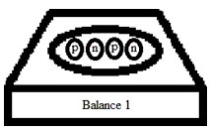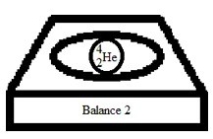Multiple Choice
Suppose you have two very sensitive balances that can measure the masses of individual particles, depicted below. In these figures, "p" corresponds to a proton, and "n" corresponds to a neutron. 
 What is the relationship between the mass readings of the two balances? (Neglect differences due to experimental uncertainty.)
What is the relationship between the mass readings of the two balances? (Neglect differences due to experimental uncertainty.)
A) The mass reading of balance 1 will be much higher than the mass reading of balance 2.
B) The mass reading of balance 1 will be slightly higher than the mass reading of balance 2.
C) The mass reading of balance 1 will be exactly the same as the mass reading of balance 2.
D) The mass reading of balance 1 will be slightly lower than the mass reading of balance 2.
E) The mass reading of balance 1 will be much lower than the mass reading of balance 2.
Correct Answer:

Verified
Correct Answer:
Verified
Q26: What is the energy equivalent of 1
Q28: When atoms of beryllium-9 are bombarded with
Q29: Which type of radiation is the least
Q30: The <sup>14</sup>C activity of some ancient Peruvian
Q32: Identify the missing species in the following
Q33: The difference between the mass of an
Q34: Which isotope, when bombarded with nitrogen-15, yields
Q35: The radiochemist, Will I. Glow, studied thorium-232
Q36: A rock contains 0.37 mg of Pb-206
Q69: Alpha particles are identical to<br>A) protons.<br>B) helium